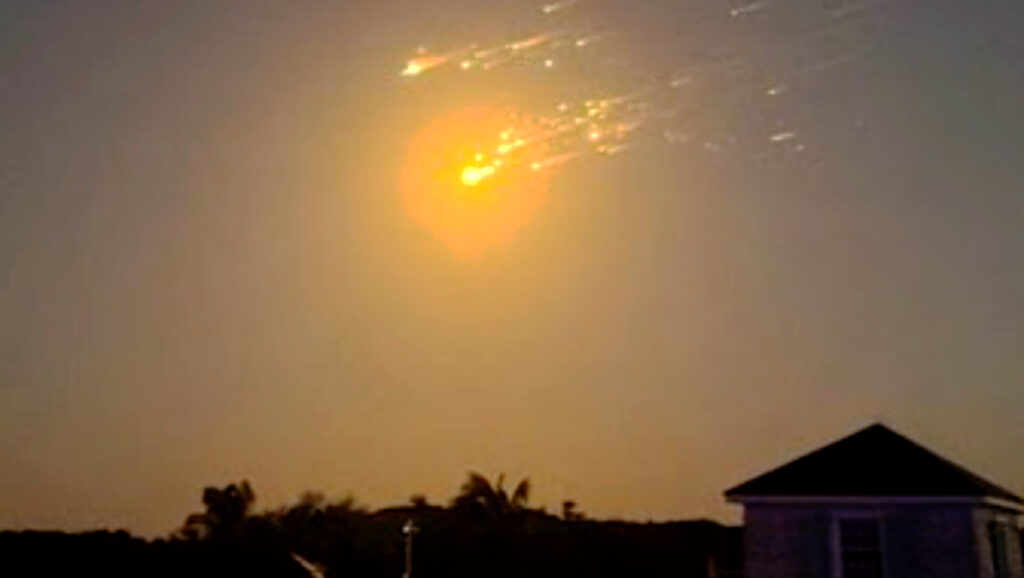SpaceX Starship Test Flight Ends in Explosion: Key Details
SpaceX’s eighth Starship test launch on March 6, 2025, ended catastrophically as the spacecraft disintegrated mid-flight, scattering debris over Florida and the Caribbean. The incident caused temporary airport ground stops and reignited debates over space debris risks.
SpaceX’s eighth Starship test launch ended in a mid-flight explosion on March 6, 2025, scattering debris over Florida and the Caribbean and triggering temporary ground stops at major airports, including Miami and Orlando.

The spacecraft, intended to deploy mock satellites, lost control nine minutes after liftoff due to engine failures, disintegrating at 90 miles altitude. The Federal Aviation Administration (FAA) halted subsequent launches pending a mishap investigation, spotlighting risks tied to space debris and rapid prototyping in private space ventures.
While no injuries were reported, the incident reignited debates over aviation safety and regulatory oversight as SpaceX aims to refine for future Mars and moon missions.
SpaceX’s eighth Starship test flight on March 6, 2025, ended abruptly when the spacecraft exploded mid-air nine minutes after launch, showering debris over Florida and the Caribbean and forcing temporary ground stops at Miami, Orlando, and Fort Lauderdale airports.
The malfunction, caused by engine failures during descent, prevented the deployment of test satellites and drew scrutiny from the Federal Aviation Administration (FAA), which launched an investigation into the mishap.
While no injuries were reported, the incident highlighted escalating concerns over space debris risks and the challenges of balancing rapid innovation with public safety, as SpaceX races to perfect for future NASA moon missions and Mars colonization plans.

What Happened During the Launch?
The 403-foot rocket lifted off from Starbase, Texas, at 5:30 PM CT. While the Super Heavy booster successfully landed, the upper-stage Starship lost control nine minutes post-launch. Critical engine failures led to a spin and breakup at 90 miles altitude, preventing the deployment of four test satellites.
Air Travel Disruptions: Flights Halted, Debris Sightings
The explosion triggered FAA-mandated ground stops at Miami, Orlando, and Fort Lauderdale airports for 90 minutes. Pilots and passengers reported flaming debris over the Caribbean, prompting emergency protocols.
Key Impacts:
- 300+ flights delayed across Florida.
- Cruise ships rerouted due to offshore debris.
- FAA issued a Notice to Air Missions (NOTAM) to avoid airspace.
SpaceX’s Starship Explosion Disrupts Air Travel, Sparks FAA Probe
SpaceX’s eighth Starship test flight on March 6, 2025, ended in a dramatic mid-air explosion nine minutes after liftoff, scattering debris across Florida, the Caribbean, and the Gulf of Mexico.
The malfunction, caused by engine failures during descent, forced the Federal Aviation Administration (FAA) to temporarily ground flights at Miami, Orlando, and Fort Lauderdale airports, delaying over 300 flights.
While no injuries were reported, flaming debris sightings triggered emergency protocols, and cruise ships rerouted to avoid offshore wreckage. The FAA mandated a “mishap investigation” to address safety risks, pausing SpaceX’s launch schedule until corrective measures are confirmed.
Elon Musk acknowledged the setback on social media, stating the team “learned much for next iteration,” as SpaceX aims to refine Starship for future Mars missions and NASA’s Artemis moon landings.

Rising Debris Risks Test Limits of Private Space Innovation
The explosion underscores growing concerns about space debris endangering populated areas and aviation corridors. This marks the fourth Starship failure since 2023, reigniting debates over SpaceX’s “test fast, fail fast” approach and regulatory gaps in managing private space ventures.
Critics highlight toxic residues from rocket fuel in debris and close calls with commercial flights, urging stricter oversight. Meanwhile, the FAA’s probe will scrutinize compliance with launch licenses, potentially delaying SpaceX’s ambitious timelines.
As the company pushes to revolutionize space travel, the incident highlights the precarious balance between pioneering innovation and safeguarding public safety—a challenge shaping the future of extraterrestrial exploration.
FAA Launches Mishap Investigation: What’s Next?
The FAA grounded Starship pending a “mishap investigation” to determine the root cause. SpaceX must address public safety risks before future launches.
Regulatory Scrutiny:
- Focus on SpaceX’s rapid prototyping approach (“test fast, fail fast”).
- Debris recovery efforts ongoing in the Bahamas and Gulf of Mexico.
- Previous Starship tests in 2023-2024 also resulted in explosions.
Why Space Debris Risks Are Rising
The incident highlights growing concerns about falling rocket parts affecting populated areas. Over 30% of SpaceX’s Starship tests since 2020 have failed, raising questions about:
- Environmental Hazards: Toxic fuel residues in debris.
- Aviation Safety: Close calls with commercial flights.
- Regulatory Gaps: Current laws lag behind private space ventures.

Starship’s Troubled History: A Timeline
- 2023: First orbital attempt exploded mid-air.
- 2024: Third test reached space but crashed on re-entry.
- March 2025: Eighth test failure triggers FAA probe.
Elon Musk tweeted post-failure: “Learned much for next iteration.” SpaceX aims to use Starship for Mars missions and NASA’s Artemis moon landings.
Q: Was anyone injured in the explosion?
A: No injuries reported; debris fell in unpopulated areas.
Q: How long will the FAA investigation take?
A: Typically 2-6 months, delaying SpaceX’s launch schedule.
Q: Will SpaceX face fines?
A: Possible if violations of launch licenses are found.
Conclusion: Balancing Innovation and Safety
While SpaceX pushes boundaries, the Starship explosion underscores the need for stricter debris mitigation and collaboration between regulators and private firms. Future tests will hinge on transparency and risk reduction.


